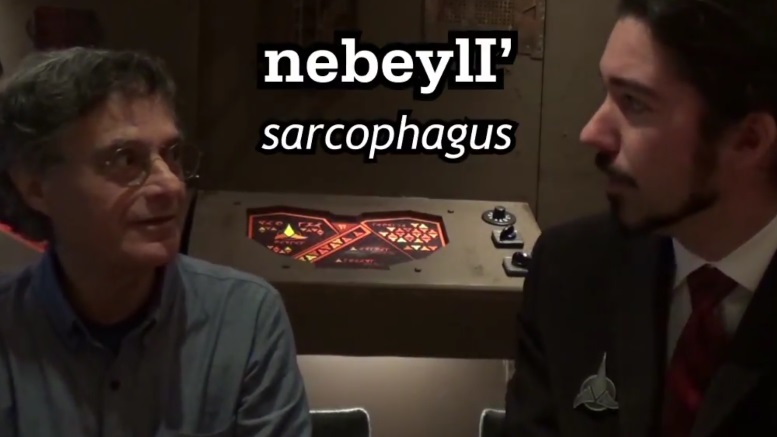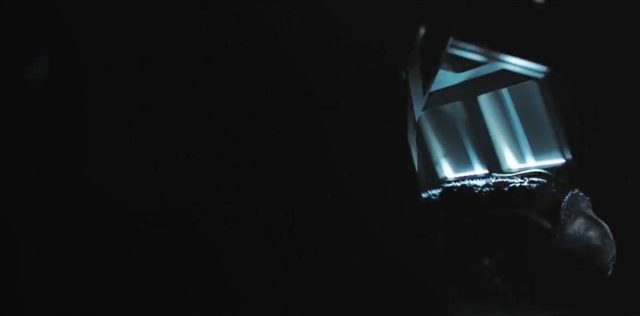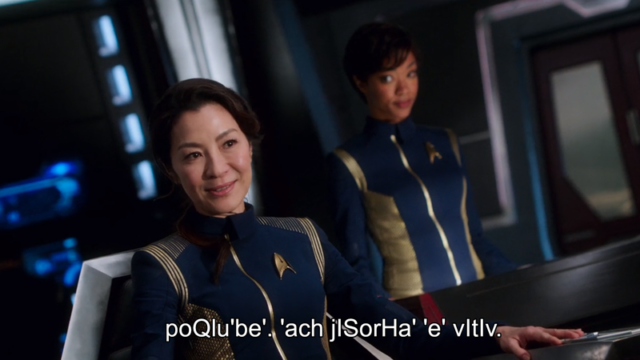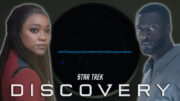One of the major elements of Star Trek: Discovery is extensive use of the Klingon language. For scenes with the Klingons they speak in Klingon with subtitles. In a new video, Lieven Litaer (aka the Klingon Teacher) speaks to Marc Okrand, the original inventor of the Klingon language, about the new additions to the Klingon language created for Discovery.
More Klingon words added for Discovery
As was noted in the video, Okrand isn’t working on Star Trek: Discovery, as the translating for the show is being handled by Klingon expert Robyn Stewart. However, Okrand is still the only person who can introduce new words into the Klingon language, which is maintained by the Klingon Language Institute. As he does at each annual conference of the KLI (called the qep’a’), Okrand introduced a number of new Klingon words in the summer of 2017. You can see the full list at KLI.org (words noted as “qep’a’ 24” were announced this year).
In addition to many new words made by request of KLI members, this years list includes a few created for Star Trek: Discovery. Some additions were seen in the premiere, such as words for sarcophagus, coffin, Andorian, and Tellarite. But, there are some new Klingon words that we may yet see on Discovery. Possibilities include naQ ‘er (a Klingon animal called a “brush devil”), wab labwI’ (radio transmitter), noDwI’ (avenger), and possibly others.
Netflix offering Klingon subtitles
The enhanced level of Klingon doesn’t end there. Those who watch Star Trek: Discovery on Netflix around the world have a special option not available to those watching in the USA and Canada. One of the subtitle language options available for the show is Klingon. The subtitle translations were done for Netflix by Lieven Litaer (from the above video).
Netflix even sent out a press release in Klingon after the show premiered earlier this week.
Kudos to @NetflixUK and their Klingon press release on #StarTrekDiscovery 🖖🏼 pic.twitter.com/ik3Rahrn4s
— Jack Quann (@jqbilbao) September 26, 2017
This is the Netflix promo video featuring Klingon dialog from that accompanied the press release.
With so much Klingon in Star Trek: Discovery it might not be a bad idea to start learning some Klingon. The KLI can help you out with that too.
Star Trek: Discovery is available exclusive in the US on CBS All Access with new episodes released Sundays at 8:30 pm ET. In Canada Star Trek: Discovery airs on the Space Channel at the same time. Discovery is available on Netflix outside the USA and Canada with new episodes made available Monday at 8 am BST.
Keep up with all the Star Trek: Discovery news at TrekMovie.








@Klingon subtitles — Ha! I was actually thinking jokingly about that being an option. Perhaps CBSAA will allow those to be turned off so that Trekies who speak Klingon won’t have to be distracted by them …
Great to see Dr Mark Okrand again. Some great stuff in the video – interesting that the presenter points out the curiousity of Klingons being inhabitants of …Qo’noS when discussing “ngan” – even though I don’t find that strange at all – after all Humans are from “Earth” and not from the the planet “Huma”.
( I’ve always had questions about whether terms like Vulcan, Tellarite, Andorian, Cardassian, etc. was really just the name for the inhabitants of a certain world ( they must be – I recall in DS9 mention of a Cardassian vole, so “Cardassian” itself can’t refer to the name of the humanoid species ).
What then, IS the actual SPECIES name for each of these humanoid races?
To me though, it always seemed logical, that we would be called Terrans, by other races, and the word “humans” would be used either as a courtesy or mockery (see Quark pronounciation).
By species name you mean scientific name, or what they call themselves? Judging from old Earth cultures, it’s very likely that alien cultures call themselves simply “people” (in their own native language, of course).
It’s also entirely possible that many alien planets are called “Earth” in their respective native languages – at least in agriculture-based civilizations, because, after all, “earth” means simply “soil”.
I know this guy is a Linguistics expert and did the Lion’s Share of the work, but I had heard that James Doohan had something to do with the development of it also.
You’re right. Doohan made up the language for Star Trek: TMP and I believe is the voice over actor for all the Klingons. Marc Okrand was hired for Star Trek: III and developed the language using Doohan’s sounds from TMP as a starting point.
So he’s *not* “the inventor of the Klingon language” then, per the misleading headline.
Boy, I really hope they get around to explaining these new Klingons’ appearance. They tease, but I’m afraid the actual answer is going to be rather inadequate. “We thought it would be cool” is a broken refrain from the recent movies.
Not gonna lie, that whole sarcophagus ship thing was pretty weird to me
Almost everything about these Klingons demands a whole lot of ‘splaining.
This isn’t nearly as beautiful as the Thermian audio track for Galaxy Quest.
I’m sorry to be off topic but it seems safer to ask this question on an unrelated article. Which episode does “the spoiler from Jonathan Frakes” spoil? Many articles reference it these days and I’m afraid to read them. When can I stop worrying?
Well, off to brush up my conversational Klingon I guess!
The only thing I wish people would do (Netflix and the Klingon language app for Android, boQwI’, I’m looking at you) is stop using a font where lowercase “L” and capital “I” look the same. When I butcher… er I mean, try to speak Klingon, I want to know if the letter is an “L” or an “I” that I’m supposed to pronounce.
As I type this lI look different (the “I” has the bars at the top and bottom), but we’ll see what it looks like when I post my comment.
That transporter effect is not canon.
Will Vulcan and Kelpian get similar treatment in the next few seasons?